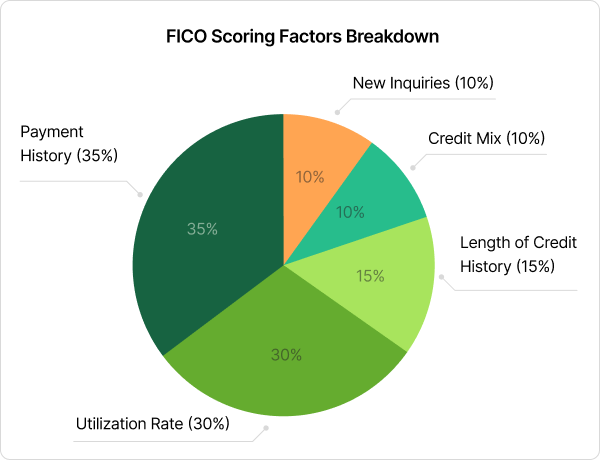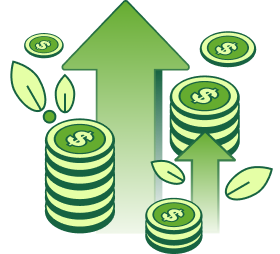Key takeaways
- Raising your rating with a credit card is one of the easiest and most effective ways to do it.
- Consistently paying on time and keeping your credit utilization low demonstrates financial reliability and improves your score.
- If you don’t want to use plastic to pay, there are other ways to boost your score, including credit builder loans and rent reporting.
Building credit with a credit card is one of the most common and easiest ways to raise your score quickly. All you have to do is use your card regularly and responsibly. Pay all your bills on time every time and only spend a small percentage of your limit. You’ll demonstrate that you can manage borrowing and repaying money on a regular basis. Keep this up, and your score will shoot up.
We’ll go over in detail with a card and what to watch out for.
How to build credit with a credit card
Building credit with a credit card begins with your credit card issuer. Issuers report your payment history and usage to the three major credit bureaus – Equifax, Experian, and TransUnion – once a month. The credit bureaus put the data into your reports, which are used to calculate your three-digit scores.
The vast majority of lenders use the FICO scoring model. FICO calculates your credit score using the following factors:

Use your card responsibly, and you’ll have a positive credit history and a good score. Here’s how you can make that happen.
1. Make on-time payments
The best thing you can do for your credit is to make on-time payments. Payment history is the most significant factor in determining your credit score. As you consistently pay on time every month, your score will go up.
Many credit card issuers allow you to set up autopay or send you bill reminders. Use these tools to your advantage so that you don’t accidentally forget.
2. Keep your credit utilization low
Your credit utilization ratio is your current balance, what you’ve spent, divided by your limit. Credit scores take into account your utilization ratio on each individual card and cumulatively across all accounts.
For example, if you have a total limit of $10,000 and are now spending $2,000, your utilization ratio is 20%. That’s a good place to be.
You want to keep your credit utilization ratio low to enhance your score. Try to keep it under 10% – but above 0%. A single-digit utilization rate can help you build credit responsibly over timeer, but it can be hard to do, especially if you have a low limit. A general rule of thumb is to keep your rate below 30%.
A high ratio implies that you are overly reliant on borrowing. When you rely on your credit card too much, you may not be able to afford the bill. Lenders prefer customers who can afford to pay on time.
3. Use your card regularly
You have to spend on credit to get credit. Use your card regularly so that the credit card issuer has information to report to the credit bureaus. Adding positive information to your credit report is the only way to improve your score.
Even if you start with the easiest unsecured credit card to get, using it consistently and responsibly can lead to better credit offers down the line.
If you don’t use your card regularly, the issuer may cancel it and close the account. Closing an account will shorten the average length of your credit history and lower your cumulative credit limit. If you don’t use your card frequently, consider putting a small recurring charge on it and setting up autopay for the full amount.
4. Become an authorized user
If you don’t want to apply for your own card, ask a trusted friend or family member if you can be an authorized user on their account. Make sure the primary cardholder has a good credit score and that the card issuer reports authorized users. That way, your score benefits from their responsible use. If you or the primary cardholder doesn’t use the card responsibly, that will affect both your scores.
5. Increase your credit limit
A higher credit limit will make it easier to maintain a low utilization rate. A lower utilization rate will help your score grow. All you have to do is keep your spending the same.
Many issuers will automatically review your account to determine if a limit increase is warranted. The best credit cards to build credit with no credit will raise your limit after six months of consistent on-time payments. You can also request an increase if you’ve consistently paid on time or received a raise at work.
6. Select the right credit card for building credit
The right credit card is the card you can get approved for with your score. What credit score do you need to get a credit card? A score of 670 or higher is a good starting point, but you still qualify with fair credit – any score over 580. Certain specialized issuers even offer credit cards to consumers with no credit history at all.
Regardless of your score, look for an affordable card with minimal fees (ideally, no annual fees and no monthly maintenance fees) and a competitive interest rate. The issuer must report to all three major credit bureaus.
The best unsecured credit cards for less than ideal credit will have few fees and offer rewards. You can usually choose between cash back and travel points or miles. If you want cash back, look for a card that offers a high percentage in categories where you already spend a significant amount.
If you’re having trouble qualifying for a credit card, consider a secured card. Secured credit cards require a refundable security deposit that sets your limit. They are easier to qualify for and often have lower fees than unsecured cards for less than ideal credit.
7. Pay off the balance in full each month
Always pay more than the minimum payment each month. Pay the entire balance if you can. Paying off your balance in full each month means you won’t pay a dime in interest.
When you only make the minimum payment, most of it goes towards the interest, and barely reduces the principal. You’ll end up paying more interest and will have a higher utilization rate.
8. Use only the credit you need
It can be tempting to use your card for everything, but resist the urge. Treat your card like a debit card and only charge what you can afford to pay for in cash. That way, you’ll have no problems paying in full by the due date.
Credit card management tips
Responsible use of a new card can have a positive impact on your score, but exactly how much a credit card will raise your score depends on your consistent payment behavior and utilization rate. To keep your score going up, follow these tips.
1. Never pay late
Always pay your bills on time. Late payments can drag down your score and remain on your credit report for up to seven years. More recent late payments will have a greater impact on your score.
If you think you’re going to be late, call your card issuer as soon as possible. You may be able to work out a payment plan or have the late fee waived, especially if you consistently make timely payments. Often, they won’t report until a payment is more than 30 days past due.
Making timely payments every month is one of the best things you can do for your credit score.
Looking for a new card but have a poor score?
2. Pay twice a month
One of the best strategies for paying your credit card bill is to pay down your balance mid-month. Paying twice a month helps you maintain a low utilization rate. You’ll end up with a lower bill at the end of the month, which will be easier to pay off in full.
One way to do this is to figure out how much you typically spend per month. Divide this sum in half and then set up autopay for after you receive your paycheck. You’ll have a lower balance without having to think about it.
You can, of course, manually pay down your balance multiple times a month if you prefer. This trick is especially helpful during the holiday season when credit card bills tend to be higher.
3. Don’t apply for too many new accounts at once
Only apply for credit accounts you need. Every time you submit an application, the financial institution will do a hard inquiry, which will temporarily lower your score. Your score should only drop by a few points and bounce back within a year. One hard inquiry isn’t a big deal, but multiple inquiries at once can cause damage. Wait six months to a year between applications.
One trick is to check eligibility without affecting your score for cards. Prequalifying does not impact your credit since the lender only conducts a soft inquiry. You’ll be able to gauge your chances of approval and then only apply for cards where you meet the basic criteria.
Want a high limit card?
How to build credit without a credit card
It is possible to raise your rating without a card. While they make it easy to improve your score, you do have to be careful and responsible, or you can go into debt. Luckily, there are alternatives to credit cards.
Credit builder loans
One option is a credit builder loan. It is a financial product that allows you to improve your score while saving money at the same time. With this loan, you don’t receive the money immediately; instead, the financial institution holds onto it and deposits it into a savings account. You make monthly payments until the loan is fully paid off. The lender reports the monthly payments to the credit bureaus, boosting your score. After you’ve made your last payment, the lender gives you the loan money, minus any fees owed or plus interest earned.
Like with any other loan, compare the fees and policies of different lenders. Before applying, you should also ensure that the lender will report payments to all three credit bureaus. Reporting payments is the only way the loan will help you improve your score.
Too many negative marks dragging your score down?
Report ALL your monthly payments
It can, but only if the payment data is reported to all three major credit bureaus. Landlords typically don’t report payments. That said, many companies report rent, utility, phone, and subscription payments. When this information is reported, the bureaus will add it to your credit reports. This way, you can improve your score with bills you’re already paying.
It’s a valuable service if you’re wary of borrowing money and going into debt or want to give your score an additional boost. As always, make sure that the service reports to all three credit bureaus. Then, continue to make on-time payments, as any reported late payments can negatively impact your score.
Use a debit card that reports payments
While prepaid credit cards to build credit don’t exist, certain debit cards can improve your score. Most of these debit cards function like secured cards without a security deposit. They report your payment activity to credit bureaus, allowing you to establish a positive payment history.
Most of them work by connecting to your bank account. The card company then sets spending limits based on your bank balance and transaction history. You can spend only within your spending limit. Most cards will debit the money directly from your account, so you don’t have to worry about paying a bill. Then the card issuer reports your payment activity to the bureaus.
Many of these debit cards charge fees, such as an annual fee. It’s essential to review the terms and conditions to understand the fees and determine if they align with your budget.
The great thing about a debit card that reports payments is that it does not involve borrowing money, so there’s no chance of going into debt. Instead, it focuses on helping you raise your rating through the responsible use of a debit card. That said, a debit card is not as effective as a credit card at improving your score.
Frequently asked questions
1. What is the fastest way to build credit using a credit card?
The fastest way to build credit using a credit card is to pay your bills on time every month and maintain a credit utilization rate under 10%. Do these two things consistently and your score will grow.
2. What is the best credit card payment method to build credit?
The method you use to pay your bill does not matter as long as it is paid on time and in full. Setting up autopay can help you avoid missing payments and establish a positive payment history.
3. How much of a $500 credit limit should I use?
Experts recommend using no more than 30% of the limit, but 10% is even better. When you have a $500 credit card limit, it’s best to keep your spending under $50 and no more than $150. Staying below this threshold helps demonstrate responsible usage and maintains a low utilization rate, which is favorable for your financial health.
4. Does paying off credit cards increase credit score?
Paying off your credit card should increase your credit score, as it will lower your credit utilization rate. Keep your credit card account open after you pay it off. Closing the account will lower your cumulative credit limit and hurt your utilization rate. It will also decrease the average length of your credit history, another scoring factor.
5. How many credit cards should I have to build credit?
Start with one or two cards at most when building credit. A low number of credit cards is easier to manage. When you only have one or two cards to keep track of you are less likely to miss payments.
Bottom line
Cards are a convenient payment system and one of the easiest ways to build credit. You have to use them responsibly for them to help you. Do not charge more than you can afford to pay for in cash. Always pay your bill on time and in full. Otherwise, they be more detrimental than beneficial.
If you think it will be hard to control how much you spend, then try a different way to improve your score. There are plenty of other options if you want to avoid debt and borrowing altogether. Ask to be an authorized user on a friend or family member’s card. Apply for a debit card that reports payments. Or use a rent reporting service. Figure out what works for you and raise your rating.



